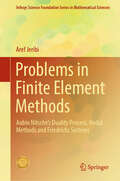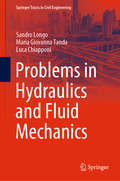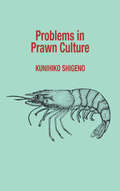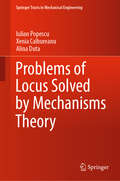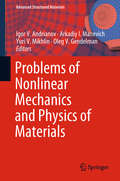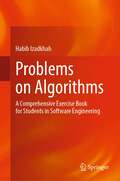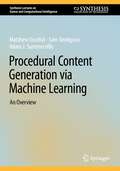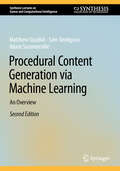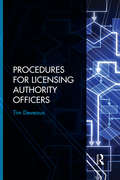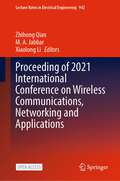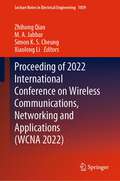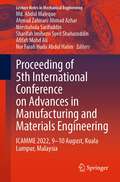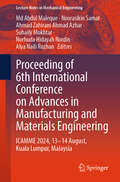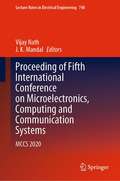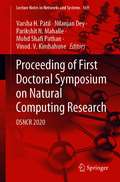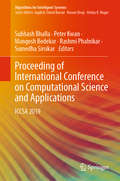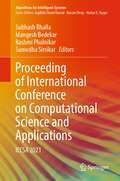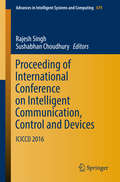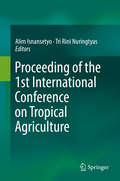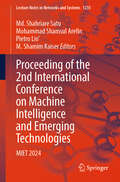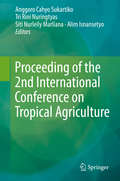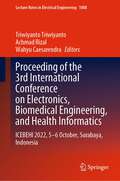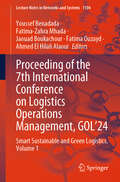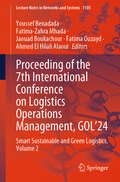- Table View
- List View
Problems in Finite Element Methods: Aubin Nitsche’s Duality Process, Nodal Methods and Friedrichs Systems (Infosys Science Foundation Series)
by Aref JeribiThis book discusses major topics and problems in finite element methods. It is targeted to graduate students and researchers in applied mathematics, physics, and engineering, wishing to learn and familiarize themselves with finite element theory. The book describes the nodal method for squares or rectangles and triangles, as well as an increase of the error between exact solution and approximate solution. It discusses an approximation of positive symmetric first-order systems in the Friedrichs sense by finite element methods. In addition, the book also explains the continuous and discontinuous approximation methods, adapted to the structure of the transport equation, leading to linear systems of quasi-explicit resolution, and therefore commonly used in practice.
Problems in Hydraulics and Fluid Mechanics (Springer Tracts in Civil Engineering)
by Sandro Longo Maria Giovanna Tanda Luca ChiapponiThis textbook offers a unique introduction to hydraulics and fluid mechanics through more than 100 exercises, with guided solutions, which students will find valuable in preparation for their preliminary or qualifying exams and for testing their grasp of the subject. In some exercises two different solution methods are proposed, to highlight the fact that the level of complexity of the calculations is often linked to the choice of method, though in most cases only the simplest method is presented. The exercises are organized by subject, covering forces on planes and curved surfaces; floating bodies; exercises that require the application of linear and angular momentum balancing in inertial and non-inertial references; pipeline systems, with particular applications to industrial plants; hydraulic systems with machines (pumps and turbines); transient phenomena in pipelines; and uniform and gradually varied flows in open channels. The book also features appendices that contain selected data and formulas of practical interest. Instructors of courses that address one or all of the above topics will find the exercises of great help in preparing their courses, while researchers will find the book useful as an accessible summary of the topics covered.
Problems in Prawn Culture
by Kunihiko ShigenoFirst published in 1984. CRC Press is an imprint of Taylor & Francis.
Problems of Locus Solved by Mechanisms Theory (Springer Tracts in Mechanical Engineering)
by Iulian Popescu Xenia Calbureanu Alina DutaThis book reports on an original approach to problems of loci. It shows how the theory of mechanisms can be used to address the locus problem. It describes the study of different loci, with an emphasis on those of triangle and quadrilateral, but not limited to them. Thanks to a number of original drawings, the book helps to visualize different type of loci, which can be treated as curves, and shows how to create new ones, including some aesthetic ones, by changing some parameters of the equivalent mechanisms. Further, the book includes a theoretical discussion on the synthesis of mechanisms, giving some important insights into the correlation between the generation of trajectories by mechanisms and the synthesis of those mechanisms when the trajectory is given, and presenting approximate solutions to this problem. Based on the authors’ many years of research and on their extensive knowledge concerning the theory of mechanisms, and bridging between geometry and mechanics, this book offers a unique guide to mechanical engineers and engineering designers, mathematicians, as well as industrial and graphic designers, and students in the above-mentioned fields alike.
Problems of Nonlinear Mechanics and Physics of Materials (Advanced Structured Materials #94)
by Oleg V. Gendelman Igor V. Andrianov Arkadiy I. Manevich Yuri V. MikhlinThis book presents contributions on the current problems in a number of topical areas of nonlinear dynamics and physics, written by experts from Russia, Ukraine, Israel, Germany, Poland, Italy, the Netherlands, the USA, and France. The book is dedicated to Professor Leonid I. Manevitch, an outstanding scholar in the fields of Mechanics of Solids, Nonlinear Dynamics, and Polymer Physics, on the occasion of his 80th birthday.
Problems on Algorithms: A Comprehensive Exercise Book for Students in Software Engineering
by Habib IzadkhahWith approximately 2500 problems, this book provides a collection of practical problems on the basic and advanced data structures, design, and analysis of algorithms. To make this book suitable for self-instruction, about one-third of the algorithms are supported by solutions, and some others are supported by hints and comments. This book is intended for students wishing to deepen their knowledge of algorithm design in an undergraduate or beginning graduate class on algorithms, for those teaching courses in this area, for use by practicing programmers who wish to hone and expand their skills, and as a self-study text for graduate students who are preparing for the qualifying examination on algorithms for a Ph.D. program in Computer Science or Computer Engineering. About all, it is a good source for exam problems for those who teach algorithms and data structure. The format of each chapter is just a little bit of instruction followed by lots of problems. This book is intended to augment the problem sets found in any standard algorithms textbook. This book • begins with four chapters on background material that most algorithms instructors would like their students to have mastered before setting foot in an algorithms class. The introductory chapters include mathematical induction, complexity notations, recurrence relations, and basic algorithm analysis methods. • provides many problems on basic and advanced data structures including basic data structures (arrays, stack, queue, and linked list), hash, tree, search, and sorting algorithms. • provides many problems on algorithm design techniques: divide and conquer, dynamic programming, greedy algorithms, graph algorithms, and backtracking algorithms. • is rounded out with a chapter on NP-completeness.
Procedural Content Generation via Machine Learning: An Overview (Synthesis Lectures on Games and Computational Intelligence)
by Matthew Guzdial Sam Snodgrass Adam J. SummervilleThis book surveys current and future approaches to generating video game content with machine learning or Procedural Content Generation via Machine Learning (PCGML). Machine learning is having a major impact on many industries, including the video game industry. PCGML addresses the use of computers to generate new types of content for video games (game levels, quests, characters, etc.) by learning from existing content. The authors illustrate how PCGML is poised to transform the video games industry and provide the first ever beginner-focused guide to PCGML. This book features an accessible introduction to machine learning topics, and readers will gain a broad understanding of currently employed PCGML approaches in academia and industry. The authors provide guidance on how best to set up a PCGML project and identify open problems appropriate for a research project or thesis. This book is written with machine learning and games novices in mind and includes discussions of practical and ethical considerations along with resources and guidance for starting a new PCGML project.
Procedural Content Generation via Machine Learning: An Overview (Synthesis Lectures on Games and Computational Intelligence)
by Matthew Guzdial Sam Snodgrass Adam SummervilleThis second edition updates and expands upon the first beginner-focused guide to Procedural Content Generation via Machine Learning (PCGML), which is the use of computers to generate new types of content for video games (game levels, quests, characters, etc.) by learning from existing content. The authors survey current and future approaches to generating video game content and illustrate the major impact that PCGML has had on video games industry. In order to provide the most up-to-date information, this new edition incorporates the last two years of research and advancements in this rapidly developing area. The book guides readers on how best to set up a PCGML project and identify open problems appropriate for a research project or thesis. The authors discuss the practical and ethical considerations for PCGML projects and demonstrate how to avoid the common pitfalls. This second edition also introduces a new chapter on Generative AI, which covers the benefits, risks, and methods for applying pre-trained transformers to PCG problems.
Procedures for Licensing Authority Officers
by Tim DeveauxLicensing law is a wide ranging , detailed and complex body of law within the UK. This book comes at a time when local authorities are required to consider and approve, or reject, applications for an increasing number and very wide range of licences. The book provides easy to read, and easy to follow procedures for a wide range of licences which local authorities and other public bodies are required by law to consider and issue. Each chapter addresses a distinct topic and the book includes guidance on local authority and court procedures. The main legal procedures used in the licensing field are presented as flow charts supported by explanatory text. Licensing professionals and students will find this essential reading. It will also be a valuable reference for all those whose responsibilities demand they keep abreast of current licensing practices.
Procedures to Investigate Foodborne Illness
by International Association for Food ProtectionProcedures to Investigate Foodborne Illness is designed to guide public health personnel or teams in any country that investigates reports of alleged foodborne illnesses. The manual is based on epidemiologic principles and investigative techniques that have been found effective in determining causal factors of disease incidence. The guidelines are presented in the sequence usually followed during investigations and are organized so that an investigator can easily find the information needed in any phase of an investigation. Included are descriptions of the following procedures: Plan, prepare, investigate and respond to intentional contamination of foodHandle illness alerts and food-related complaints that may be related to illnessInterview ill persons, those at risk, and controlsDevelop a case definitionCollect and ship specimens and food samplesConduct hazard analysis (environmental assessments) at sites where foods responsible for outbreaks were produced, processed, or preparedTrace sources of contaminationIdentify factors responsible for contamination, survival of pathogenic microorganisms or toxic substances, and/or propagation of pathogensCollate and interpret collected dataReport information about the outbreakThis edition also contains extensively updated and more user-friendly keys to assist investigators in identifying the contributing factors that may lead to the contamination, proliferation or survival of agents of foodborne disease.
Proceeding of 2021 International Conference on Wireless Communications, Networking and Applications (Lecture Notes in Electrical Engineering)
by Xiaolong Li M. A. Jabbar Zhihong QianThis open access proceedings includes original, unpublished, peer-reviewed research papers from the International Conference on Wireless Communications, Networking and Applications (WCNA2021), held in Berlin, Germany on December 17-19th, 2021. The topics covered include but are not limited to wireless communications, networking and applications.The papers showcased here share the latest findings on methodologies, algorithms and applications in communication and network, making the book a valuable asset for professors, researchers, engineers, and university students alike.This is an open access book.
Proceeding of 2022 International Conference on Wireless Communications, Networking and Applications (Lecture Notes in Electrical Engineering #1059)
by Xiaolong Li Simon K. S. Cheung M. A. Jabbar Zhihong QianThis proceedings includes original, unpublished, peer-reviewed research papers from the International Conference on Wireless Communications, Networking and Applications (WCNA2022), held in Wuhan, Hubei, China, from December 16 to 18, 2022. The topics covered include but are not limited to wireless communications, networking and applications.The papers showcased here share the latest findings on methodologies, algorithms and applications in communication and network, making the book a valuable asset for professors, researchers, engineers, and university students alike.
Proceeding of 5th International Conference on Advances in Manufacturing and Materials Engineering: ICAMME 2022, 9—10 August, Kuala Lumpur, Malaysia (Lecture Notes in Mechanical Engineering)
by Md. Abdul Maleque Ahmad Zahirani Ahmad Azhar Norshahida Sarifuddin Sharifah Imihezri Syed Shaharuddin Afifah Mohd Ali Nor Farah Huda Abdul HalimThis book presents the proceeding of 5th International Conference on Advances in Manufacturing and Materials Engineering (ICAMME2022), August 9–10, Kuala Lumpur, Malaysia. It presents articles in topics that outline the state-of-the-art information in manufacturing and materials engineering for academia and industries. The topics represent the strong synergy between manufacturing, materials, design, and management supporting the transition from product service systems to life cycle engineering services as a contributor to high value manufacturing. The scope of this book also presents a set of new additive manufacturing, 3D printing, and advanced materials with new technology; green technology for United Nations SDGs; modeling & simulation of materials and manufacturing with some classical case examples. It caters to academics and industrial practitioners who have research interest in the latest advances in manufacturing and materials engineering.
Proceeding of 6th International Conference on Advances in Manufacturing and Materials Engineering: ICAMME 2024, 13—14 August, Kuala Lumpur, Malaysia (Lecture Notes in Mechanical Engineering)
by Md Abdul Maleque Ahmad Zahirani Ahmad Azhar Noorasikin Samat Suhaily Mokhtar Norhuda Hidayah Nordin Alya Naili Rozhans book presents the proceeding of 6th International Conference on Advances in Manufacturing and Materials Engineering (ICAMME 2024), August 13–14, Kuala Lumpur, Malaysia. It presents articles in topics that outline the state-of-the-art information in manufacturing and materials engineering for academia and industries. The topics represent the strong synergy between manufacturing, materials, design, and management supporting the transition from product service systems to life cycle engineering services as a contributor to high-value manufacturing. The scope of this book also presents a set of new additive manufacturing, 3D printing, and advanced materials with new technology; green technology for United Nations SDGs; modeling and simulation of materials and manufacturing with some classical case examples. It caters to academics and industrial practitioners who have research interests in the latest advances in manufacturing and materials engineering.
Proceeding of Fifth International Conference on Microelectronics, Computing and Communication Systems: MCCS 2020 (Lecture Notes in Electrical Engineering #748)
by J. K. Mandal Vijay NathThis book presents high-quality papers from the Fifth International Conference on Microelectronics, Computing & Communication Systems (MCCS 2020). It discusses the latest technological trends and advances in MEMS and nanoelectronics, wireless communication, optical communication, instrumentation, signal processing, image processing, bioengineering, green energy, hybrid vehicles, environmental science, weather forecasting, cloud computing, renewable energy, RFID, CMOS sensors, actuators, transducers, telemetry systems, embedded systems and sensor network applications. It includes papers based on original theoretical, practical and experimental simulations, development, applications, measurements and testing. The applications and solutions discussed here provide excellent reference material for future product development.
Proceeding of First Doctoral Symposium on Natural Computing Research: DSNCR 2020 (Lecture Notes in Networks and Systems #169)
by Nilanjan Dey Parikshit N. Mahalle Varsha H. Patil Mohd Shafi Pathan Vinod. V. KimbahuneThe book is a collection of papers presented at First Doctoral Symposium on Natural Computing Research (DSNCR 2020), held during 8 August 2020 in Pune, India. The book covers different topics of applied and natural computing methods having applications in physical sciences and engineering. The book focuses on computer vision and applications, soft computing, security for Internet of Things, security in heterogeneous networks, signal processing, intelligent transportation system, VLSI design and embedded systems, privacy and confidentiality, big data and cloud computing, bioinformatics and systems biology, remote healthcare, software security, mobile and pervasive computing, biometrics-based authentication, natural language processing, analysis and verification techniques, large scale networking, distributed systems, digital forensics, and human–computer interaction.
Proceeding of International Conference on Computational Science and Applications: ICCSA 2019 (Algorithms for Intelligent Systems)
by Subhash Bhalla Peter Kwan Mangesh Bedekar Rashmi Phalnikar Sumedha SirsikarThe book consists of high-quality papers presented at the International Conference on Computational Science and Applications (ICCSA 2019), held at Maharashtra Institute of Technology World Peace University, Pune, India, from 7 to 9 August 2019. It covers the latest innovations and developments in information and communication technology, discussing topics such as soft computing and intelligent systems, web of sensor networks, drone operating systems, web of sensor networks, wearable smart sensors, automated guided vehicles and many more.
Proceeding of International Conference on Computational Science and Applications: ICCSA 2021 (Algorithms for Intelligent Systems)
by Subhash Bhalla Mangesh Bedekar Rashmi Phalnikar Sumedha SirsikarThis book consists of high-quality papers presented at the International Conference on Computational Science and Applications (ICCSA 2021), held at Maharashtra Institute of Technology World Peace University, Pune, India, from 10 – 11 December 2021. It covers the latest innovations and developments in information and communication technology, discussing topics such as algorithms, data structures and applications; wireless and mobile networks; computer networks and communications; natural language processing and information theory; cryptography and information security.
Proceeding of International Conference on Intelligent Communication, Control and Devices
by Rajesh Singh Sushabhan ChoudhuryThe book presents high-quality research papers presented at the first international conference, ICICCD 2016, organised by the Department of Electronics, Instrumentation and Control Engineering of University of Petroleum and Energy Studies, Dehradun on 2nd and 3rd April, 2016. The book is broadly divided into three sections: Intelligent Communication, Intelligent Control and Intelligent Devices. The areas covered under these sections are wireless communication and radio technologies, optical communication, communication hardware evolution, machine-to-machine communication networks, routing techniques, network analytics, network applications and services, satellite and space communications, technologies for e-communication, wireless Ad-Hoc and sensor networks, communications and information security, signal processing for communications, communication software, microwave informatics, robotics and automation, optimization techniques and algorithms, intelligent transport, mechatronics system, guidance and navigation, algorithms, linear/non-linear control, home automation, sensors, smart cities, control systems, high performance computing, cognition control, adaptive control, distributed control, prediction models, hybrid control system, control applications, power system, manufacturing, agriculture cyber physical system, network control system, genetic control based, wearable devices, nano devices, MEMS, bio-inspired computing, embedded and real-time software, VLSI and embedded systems, FPGA, digital system and logic design, image and video processing, machine vision, medical imaging, and reconfigurable computing systems.
Proceeding of the 1st International Conference on Tropical Agriculture
by Alim Isnansetyo Tri Rini NuringtyasThe proceeding of tropical agriculture is a proceeding of papers presented at the International Conference on Tropical Agriculture. Sustainability of agriculture production system is an important issue in the world, which includes all aspects of sustainable criteria, such as technical, socio-economic, and ecological aspects. This book covers sustainable tropical agriculture, sustainable tropical fisheries, sustainable tropical animal production, sustainable tropical forestry, tropical animal health, and Innovative and Emerging Food Technology and Management. The most common, challenging issues in plant, animal and fisheries production in the tropics are climate change, inefficiency production system, low technological innovation, decreasing environment quality, and the outbreak risk of pest and diseases. These issues are closely linked to the socio-economic condition of farmers as small-scale farms are dominant in this area. In addition, post-harvest technology is crucial to maintaining the high quality of products after on farm production. This volume provides the recent research and development on tropical agriculture production systems for plant, terrestrial animal and aquatic animal to establish sustainable agriculture production in the tropics.
Proceeding of the 2nd International Conference on Machine Intelligence and Emerging Technologies: MIET 2024 (Lecture Notes in Networks and Systems #1235)
by M. Shamim Kaiser Mohammad Shamsul Arefin Md. Shahriare Satu Pietro Lio'This book is a collection of high-quality research papers presented at the Second International Conference on Machine Intelligence and Emerging Technologies, MIET 2024, hosted by Noakhali Science and Technology University, Noakhali, Bangladesh, during 8-9 November 2024. This book focuses on theoretical, practical, state-of-art applications, and research challenges in the field of artificial intelligence and emerging technologies. It is helpful for active researchers and practitioners in this field.
Proceeding of the 2nd International Conference on Tropical Agriculture
by Alim Isnansetyo Tri Rini Nuringtyas Anggoro Cahyo Sukartiko Siti Nurleily MarlianaThis book covers the sustainable tropical agriculture, sustainable tropical animal production and health, sustainable tropical forestry, socio-economic dimension in tropical agriculture and innovative and emerging food technology and management as chapters in this book. The common challenging problems in plant, animal, and fisheries production in the tropic are climate change, inefficiency production system, low technological innovation, decreasing environment quality, and the outbreak risk of pest and diseases.
Proceeding of the 3rd International Conference on Electronics, Biomedical Engineering, and Health Informatics: ICEBEHI 2022, 5–6 October, Surabaya, Indonesia (Lecture Notes in Electrical Engineering #1008)
by Achmad Rizal Wahyu Caesarendra Triwiyanto TriwiyantoThis book presents high-quality peer-reviewed papers from the International Conference on Electronics, Biomedical Engineering, and Health Informatics (ICEBEHI) 2022 held at Surabaya, Indonesia, virtually. The contents are broadly divided into three parts: (a) Electronics, (b) Biomedical Engineering, and (c) Health Informatics. The major focus is on emerging technologies and their applications in the domain of biomedical engineering. It includes papers based on original theoretical, practical, and experimental simulations, development, applications, measurements, and testing. Featuring the latest advances in the field of biomedical engineering applications, this book serves as a definitive reference resource for researchers, professors, and practitioners interested in exploring advanced techniques in the fields of electronics, biomedical engineering, and health informatics. The applications and solutions discussed here provide excellent reference material for future product development.
Proceeding of the 7th International Conference on Logistics Operations Management, GOL'24: Smart Sustainable and Green Logistics, Volume 1 (Lecture Notes in Networks and Systems #1104)
by Youssef Benadada Fatima-Zahra Mhada Jaouad Boukachour Fatima Ouzayd Ahmed El Hilali AlaouiThis book presents the advances in the concept, model, method, and tools for the global supply chain management. The conference took place in Marrakesh from May 2 to May 4, 2024. The 7th edition of this conference focused on Smart Sustainable and Green Logistics. The papers included in the book's proceedings cover various themes, such as: . Metaheuristics for industry 4.0 . Multi-agent systems for solving combinatorial optimization problems . Sustainability in supply chain management: a paradigm for global transformation . Sustainable and agile supply chain management . Sustainable and smart management of water resources: innovative optimization . Artificial intelligence and emerging technologies: advancements and applications . Artificial intelligence techniques and statistical modeling for mobility and urban logistics planning . Smart and green process in transport and logistics . Viability of logistics networks, structural dynamics and recovery strategy—low certainty context . Modeling, simulation and optimization . Planning and scheduling . Decision support systems . Risk management . Project management . Information systems integration . Supply chain design and control . Models and algorithms for electric mobility
Proceeding of the 7th International Conference on Logistics Operations Management, GOL'24: Smart Sustainable and Green Logistics, Volume 2 (Lecture Notes in Networks and Systems #1105)
by Youssef Benadada Fatima-Zahra Mhada Jaouad Boukachour Fatima Ouzayd Ahmed El Hilali AlaouiThis book presents the advances in the concept, model, method, and tools for the global supply chain management. The conference took place in Marrakesh from May 2 to May 4, 2024. The 7th edition of this conference focused on Smart Sustainable and Green Logistics. The papers included in the book's proceedings cover various themes, such as: . Metaheuristics for industry 4.0 . Multi-agent systems for solving combinatorial optimization problems . Sustainability in supply chain management: a paradigm for global transformation . Sustainable and agile supply chain management . Sustainable and smart management of water resources: innovative optimization . Artificial intelligence and emerging technologies: advancements and applications . Artificial intelligence techniques and statistical modeling for mobility and urban logistics planning . Smart and green process in transport and logistics . Viability of logistics networks, structural dynamics and recovery strategy—low certainty context . Modeling, simulation and optimization . Planning and scheduling . Decision support systems . Risk management . Project management . Information systems integration . Supply chain design and control . Models and algorithms for electric mobility
